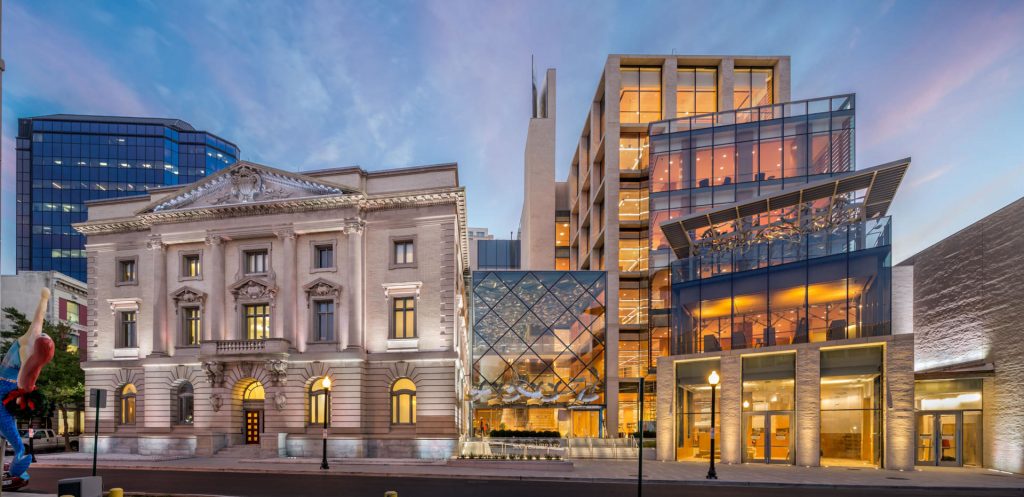Slover Library 35 E. Plume Street, Norfolk, VA 23510
The Slover Memorial Main Branch is a library that stands alongside several other city establishments in downtown Norfolk, Virginia. It’s exterior is uniquely designed; the left building presenting a classical structure composed of sections of stone, paneled windows and towering columns with three floors and one entrance through a grandiose, wooden double-door, while contemporary large glass windows displaying the interior of each of the six floors construct the right portion of the library. Overall, I would compare the Slover library building to that of a modern art gallery or high-fashion department store, fitting nicely to the metropolitan-like aesthetic of the rest of East Plume Street. While this is my own – interpretation of the Slover library’s exterior, it’s environment could be considered a prime example of the study from Mathew and Soistmann’s article, “Encoding Space: Shaping learning environments that unlock human potential” pointing out the influence our physical surroundings have on us (2020). Specifically when the article references makerspaces, a component that is recently was added to the Slover library, and how these spaces compliment each other and can contribute to “create opportunities for people to bond with and within our environments” (Mathews, Soistmann, 2020).
Outside the Slover library is an entrance space including a small area for seating, stairs, a ramp, and depending on the side of the library you’re on, either a large double-wooden door or an automatic glass sliding door. Echoing Traci Lesneski’s article, “Why Outdoor Spaces Are Essential for the 21st-Century Library” the previously mentioned adornment of the right wing of Slover library, ladened with glass windows to the outside city, significantly conveys to the idea of “having a relationship with the outdoors from inside the building” (2016). I can attest from my own experience studying at the Slover library and utilizing their materials that the visual connection to the outdoors and the cityscape around it, is one of my favorite things about the space (Lesneski, 2016). Beyond the outside space of Slover library’s entrance, you will find yourself in the center of downtown Norfolk. Home to local businesses such as those housed adjacent in the Selden Market, apartment complexes, the MacArthur mall, and a few blocks away from Waterside where you can find sailboats and small cruises coming into port.
From the outside signage, you can learn the Slover Library’s hours of operations, special events upcoming, and the covid-19 precautions in place. There is also an outside return service for physical books and for digital media items.
The Slover library is also at a great location for surrounding parking and public transportation. The Tide Light Rail takes commuters from Fort Norfolk Station, near the historic Ghent district, to the Newtown Road Park & Ride Station at the Norfolk/Virginia Beach city line, and a stop for the light rail is right across the street from the library. The Slover library is also near HRT bus stops, and has many surrounding opportunities for parking, whether it be on the street or in one of downtown Norfolk’s parking garages.
I find the Slover Library incredibly welcoming to all patrons visiting the Downtown Norfolk area.
References
Aaron, P. (2021). Norfolk Public Library Slover Memorial Main Branch [Photograph]. Newman Architects. United States. https://www.artic.edu/aic/collections/artowrk/6565
Lesneski, T. (2016, Aug. 13). Why Outdoor Spaces Are Essential for the 21st-Century Library. Demco Interiors. https://www.demcointeriors.com/blog/why-outdoor-spaces-are-essential-for-the-21st-century-library/
Mathews, B. & Soistmann, L. A. (2020). Encoding Space: Shaping learning environments that unlock human potential. American Libraries. https://americanlibrariesmagazine.org/2020/09/01/encoding-space-library-design/



5 responses to “Library Visit #2”